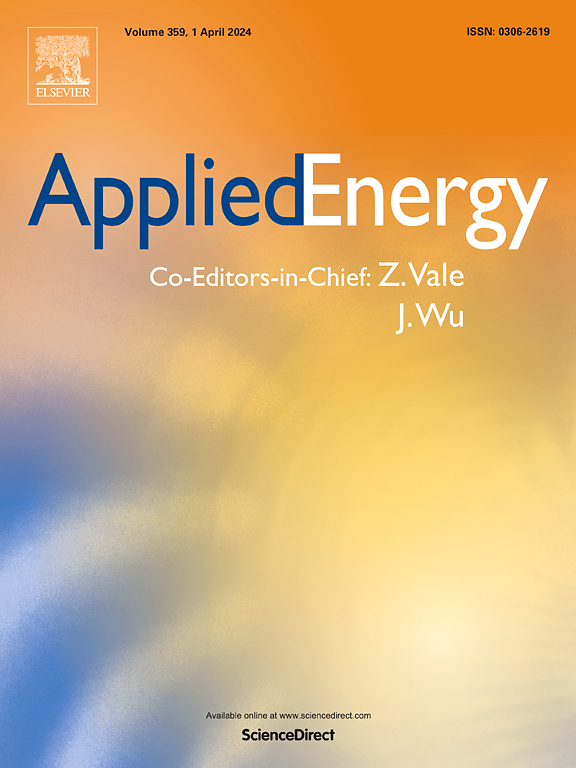基于热匹配的跨临界CO2动力循环蓄热器分区设计方法
IF 11
1区 工程技术
Q1 ENERGY & FUELS
引用次数: 0
摘要
蓄热器是影响CO2朗肯循环效率的关键部件。蓄热器内冷热工质的传热匹配程度是决定蓄热器耦合传热效率的核心因素。然而,由于CO2在临界区域的热物性发生了显著的非线性变化,导致蓄热器冷热侧CO2的热容严重失配,从而显著降低了蓄热器的耦合换热性能。针对这一问题,提出了基于热匹配的蓄热器分区设计方法。该方法通过识别热物性失配区域,优化区域内换热结构,实现冷热侧更好的换热性能匹配。此外,与常用的全优化方法相比,流动性能得到了显著改善。在本研究中,提出了一个错配程度指数来量化错配区域的大小。利用三维数值模型研究了该方法在不同工况下的性能优化效果。随后,建立了一维预测模型和零维预测表达式,快速准确地计算出失配区域的位置。最后,对该再生器进行了实验测试。在此基础上,根据所提出的方法进行了优化。结果表明,该分区设计方法在各种工况下都能提供良好的性能优化。以牺牲单位压降为代价,通过分区设计方法获得的换热增量比完全优化结构的换热增量大51%。所建立的一维预测模型最大误差为3.3%,具有较好的精度。相比之下,零维预测表达式的最大误差为20%,可靠性合理,但精度较低。对失配区位置影响最大的运行参数是冷侧压力和换热量。与原蓄热器相比,优化结构的耦合传热性能提高了6.6%。该研究为改善热物性特征变化较大的工质间的耦合换热性能提供了一种新方法。本文章由计算机程序翻译,如有差异,请以英文原文为准。
A partitioning design method for regenerator in transcritical CO2 power cycle based on heat matching
The regenerators are the key components affecting the efficiency of CO2 rankine cycle. The degree of heat transfer matching between the hot and cold working fluids in the regenerator is the core factor that determines its coupled heat transfer efficiency. However, due to the significant nonlinear variation of the thermophysical properties of CO2 in the critical region, it leads to a serious mismatch in the heat capacity of CO2 on the hot and cold-sides of the regenerator, which significantly reduces its coupled heat transfer performance. To address this issue, the partitioning design method for the regenerator based on thermal matching is proposed. The method achieves better heat transfer performance matching between the hot and cold-sides by identifying thermophysical property mismatch region and optimising the heat exchange structure within. In addition, the flow performance is significantly improved compared with the commonly used full optimisation methods. In this study, a mismatch degree index is proposed to quantify the size of mismatch regions. A three-dimensional numerical model was then used to investigate the performance optimization effect of the proposed method under various operating conditions. Subsequently, a one-dimensional predictive model and a zero-dimensional predictive expression were developed to quickly and accurately calculate the mismatch region locations. Finally, experimental tests were conducted for the regenerator. Based on this, it was optimised according to the proposed method. The results demonstrate that the partitioning design method offers excellent performance optimization across various operating conditions. At the cost of sacrificing unit pressure drop, the heat transfer increment achievable through the partitioning design method is 51 % greater than that of the fully optimised structure. The one-dimensional predictive model developed exhibits a maximum error of 3.3 %, indicating good accuracy. In contrast, the zero-dimensional predictive expression has a maximum error of 20 %, providing reasonable reliability but with lower precision. The operating parameters that most influence the location of the mismatch region are cold-side pressure and heat transfer quantity. The coupled heat transfer performance of the optimised structure is improved by 6.6 % compared with the original regenerator. The research provides a new method for improving the coupled heat transfer performance between working fluids with strongly variable thermophysical property characteristics.
求助全文
通过发布文献求助,成功后即可免费获取论文全文。
去求助
来源期刊

Applied Energy
工程技术-工程:化工
CiteScore
21.20
自引率
10.70%
发文量
1830
审稿时长
41 days
期刊介绍:
Applied Energy serves as a platform for sharing innovations, research, development, and demonstrations in energy conversion, conservation, and sustainable energy systems. The journal covers topics such as optimal energy resource use, environmental pollutant mitigation, and energy process analysis. It welcomes original papers, review articles, technical notes, and letters to the editor. Authors are encouraged to submit manuscripts that bridge the gap between research, development, and implementation. The journal addresses a wide spectrum of topics, including fossil and renewable energy technologies, energy economics, and environmental impacts. Applied Energy also explores modeling and forecasting, conservation strategies, and the social and economic implications of energy policies, including climate change mitigation. It is complemented by the open-access journal Advances in Applied Energy.
 求助内容:
求助内容: 应助结果提醒方式:
应助结果提醒方式:


